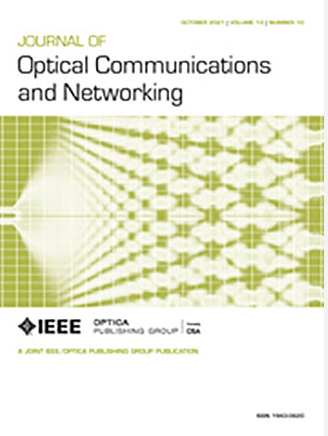工业流中TSN和TDM-PON混合网络的协同调度和路由
IF 4.3
2区 计算机科学
Q1 COMPUTER SCIENCE, HARDWARE & ARCHITECTURE
引用次数: 0
摘要
随着智能制造的发展,信息技术(IT)和运营技术(OT)逐渐融合,承载着具有时间敏感性和带宽饥渴性的各类产业流。为了满足用户的通信需求,将时分多路无源光网络(tdm - pon)与时敏网络(tsn)相结合的混合组网技术已成为一种发展趋势。TDM-PON为南北通信提供增强的带宽,而TSN为东西通信提供更大的灵活性。然而,这种集成带来了与穿越TSN和PON域的端到端(E2E)工业流延迟相关的挑战。传统的调度方法只能保证每个域内的确定性传输,导致可调度性降低,资源利用率低下。为了解决这些问题,我们提出了一种跨TSN和PON域的协同调度和路由方案,旨在实现端到端工业流的全局优化。首先,我们引入了一个光学TSN模型,作为TDM-PON的TSN等效模型。通过将TDM-PON和传统TSN交换机作为一个统一的网络域来处理,可以实现协同调度和路由。这种协同调度方法可以从整体上考虑延迟预算,从而促进端到端确定性传输。我们利用在我们之前的工作中提出的时间感知传输窗口和循环传输窗口(C-TW)策略来确保同步和异步周期流的确定性。此外,我们提出了一个整数线性规划(ILP)模型和一个“零等待”启发式算法来提高可调度性和资源利用效率。仿真结果表明,该协同调度方案的平均可调度性和资源利用效率分别比传统非协作调度方案提高20.83%和41.37%。本文章由计算机程序翻译,如有差异,请以英文原文为准。
CO-scheduling and routing in a hybrid TSN and TDM-PON network for industrial flows
With the development of smart manufacturing, information technology (IT) and operation technology (OT) are gradually converging to carry various types of industrial flows that are characterized by time sensitivity and bandwidth hunger. To cope with their communication needs, hybrid networking technology has become a trend, where integrating time-division multiplexed passive optical networks (TDM-PONs) with time-sensitive networks (TSNs) is garnering considerable attention. TDM-PON offers enhanced bandwidth for north–south communications, while TSN delivers greater flexibility for east–west communications. However, this integration presents challenges related to delay in end-to-end (E2E) industrial flows traversing both the TSN and PON domains. Traditional scheduling approaches only guarantee deterministic transmission within each domain that leads to reduced schedulability and inefficient resource utilization. To address these issues, we propose a cooperative scheduling (CO-scheduling) and routing scheme that spans both the TSN and PON domains, aiming for a global optimization of E2E industrial flows. Initially, we introduce an Optical TSN model, which serves as a TSN equivalent for TDM-PON. By treating TDM-PON and traditional TSN switches as a unified network domain, we can implement CO-scheduling and routing. This CO-scheduling approach can facilitate E2E deterministic transmission by considering the delay budget as a whole. We utilize time-aware transmission window and cyclic transmission window (C-TW) strategies that were proposed in our previous works to ensure the determinism of synchronous and asynchronous periodic flows, respectively. Moreover, we propose an integer linear programming (ILP) model and a “zero-waiting” heuristic algorithm to enhance schedulability and resource utilization efficiency. Simulation results show that the average schedulability and resource utilization efficiency of the CO-scheduling scheme are up to 20.83% and 41.37% higher than that of the traditional non-cooperative scheduling scheme, respectively.
求助全文
通过发布文献求助,成功后即可免费获取论文全文。
去求助
来源期刊
CiteScore
9.40
自引率
16.00%
发文量
104
审稿时长
4 months
期刊介绍:
The scope of the Journal includes advances in the state-of-the-art of optical networking science, technology, and engineering. Both theoretical contributions (including new techniques, concepts, analyses, and economic studies) and practical contributions (including optical networking experiments, prototypes, and new applications) are encouraged. Subareas of interest include the architecture and design of optical networks, optical network survivability and security, software-defined optical networking, elastic optical networks, data and control plane advances, network management related innovation, and optical access networks. Enabling technologies and their applications are suitable topics only if the results are shown to directly impact optical networking beyond simple point-to-point networks.

 求助内容:
求助内容: 应助结果提醒方式:
应助结果提醒方式:


